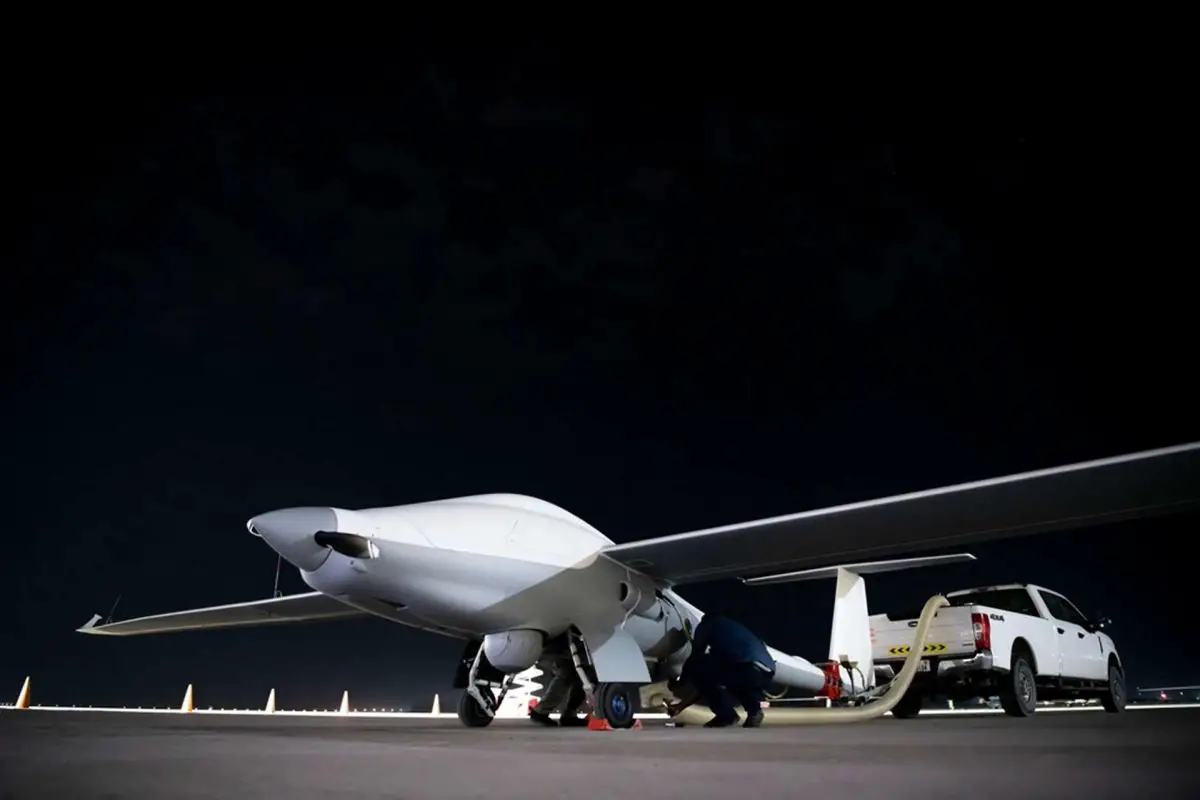Breaking news
US Air Force deploys $8 million secret ULTRA unmanned aircraft in United Arab Emirates.
On May 7, 2024, the US Air Force deployed an Unmanned Long-endurance Tactical Reconnaissance Aircraft (ULTRA) for an early morning mission at Al Dhafra Air Base, a hub for the 380th Air Expeditionary Wing and previously used for RQ-4 Global Hawk ISR drones, located in the United Arab Emirates. Each ULTRA aircraft is said to cost about $8 million, and the Air Force plans to acquire and operate at least four more by fiscal 2025.
Follow Army Recognition on Google News at this link

Each ULTRA aircraft is said to cost about $8 million, and the Air Force plans to acquire and operate at least four more by fiscal 2025. (Picture source: US DoD)
This deployment is part of a $30 million project to demonstrate the capabilities of the ULTRA, highlighting its ability to provide continuous surveillance over extended periods. Developed by the Air Force Research Laboratory (AFRL) Center for Rapid Innovation (CRI) and Dzyne Technologies Incorporated, the ULTRA is an uncrewed aerial system (UAS) designed to deliver extended intelligence, surveillance, and reconnaissance (ISR) capabilities at a lower cost and with a smaller operational footprint compared to other systems in its class.
For the United States, traditional ISR platforms faced limitations in endurance and cost-efficiency, particularly in regions with limited basing options or where long-range operations were required. This need became more pronounced with the strategic pivot to the Asia-Pacific region, where vast distances and a lack of forward bases challenged conventional ISR operations. To address the need for persistent ISR capabilities in remote and hard-to-access areas, the AFRL used the foundations laid by earlier programs like the Long Endurance Aircraft Program (LEAP) to initiate the ULTRA project.
The LEAP program involved the conversion of manned sport gliders into unmanned systems for special operations missions. Insights and technologies from LEAP contributed to the rapid development and deployment of the ULTRA project. Collaboration with Dzyne Technologies Incorporated, a company known for its innovative approaches to aviation and UAS development, was crucial in bringing the ULTRA project from concept to reality in under a year.
Initial flight tests for the ULTRA project began in 2019, with the first operational demonstrations taking place at Wright-Patterson Air Force Base in Ohio. These tests validated the aircraft's capabilities, including a continuous flight demonstration lasting two and a half days. Since then, this drone, built upon a proven avionics system with over 50,000 operational hours, has undergone further refinements and has already been operationally deployed in regions such as the Middle East, where it supports US Central Command (CENTCOM) ISR operations from bases like Al Dhafra Air Base in the UAE.
As with the LEAP program, the ULTRA UAV is based on a repurposed manned commercial sport glider, combining the aerodynamic efficiency of a glider with the advanced capabilities of modern ISR platforms. Derived from the Stemme S12 motor glider and modified with a turbocharger for high-altitude flight, the ULTRA aircraft has a sailplane-like design, characterized by long wings with winglets, a T-tail, and a retractable undercarriage. This configuration contributes to its high aerodynamic efficiency and extended flight endurance. An EO/IR sensor turret is mounted below the fuselage, just ahead of the wing, providing 360-degree surveillance capabilities. Additional sensor packages can be integrated depending on mission requirements.
By exploiting commercial aircraft production lines and utilizing commercial-off-the-shelf (COTS) technology, the ULTRA achieves significantly lower production and maintenance costs. This approach allows the United States to procure and operate multiple units globally, enhancing both ISR coverage and large-scale deployment without incurring prohibitive expenses. The command and control system of the ULTRA, designed to be user-friendly, features "point and click" operations to reduce the training requirements for operators and simplify mission planning and execution. Equipped with satellite-based command and control links, the ULTRA drone can operate globally, providing real-time high-rate ISR data feeds to operators anywhere in the world.
Additionally, the Unmanned Long-endurance Tactical Reconnaissance Aircraft (ULTRA) is capable of flying for over 80 hours continuously, significantly surpassing the endurance of many existing UAS platforms, only surpassed by the Emirati Yabhon United 40 and the British Hybrid Air Vehicles HAV-3. This extended flight time allows for prolonged ISR missions in critical areas without the need for frequent returns to base. The aircraft can carry over 400 pounds of payload, supporting a variety of sensors and surveillance equipment, including electro-optical/infrared (EO/IR) sensors, electronic surveillance systems, and synthetic aperture radar (SAR).


























